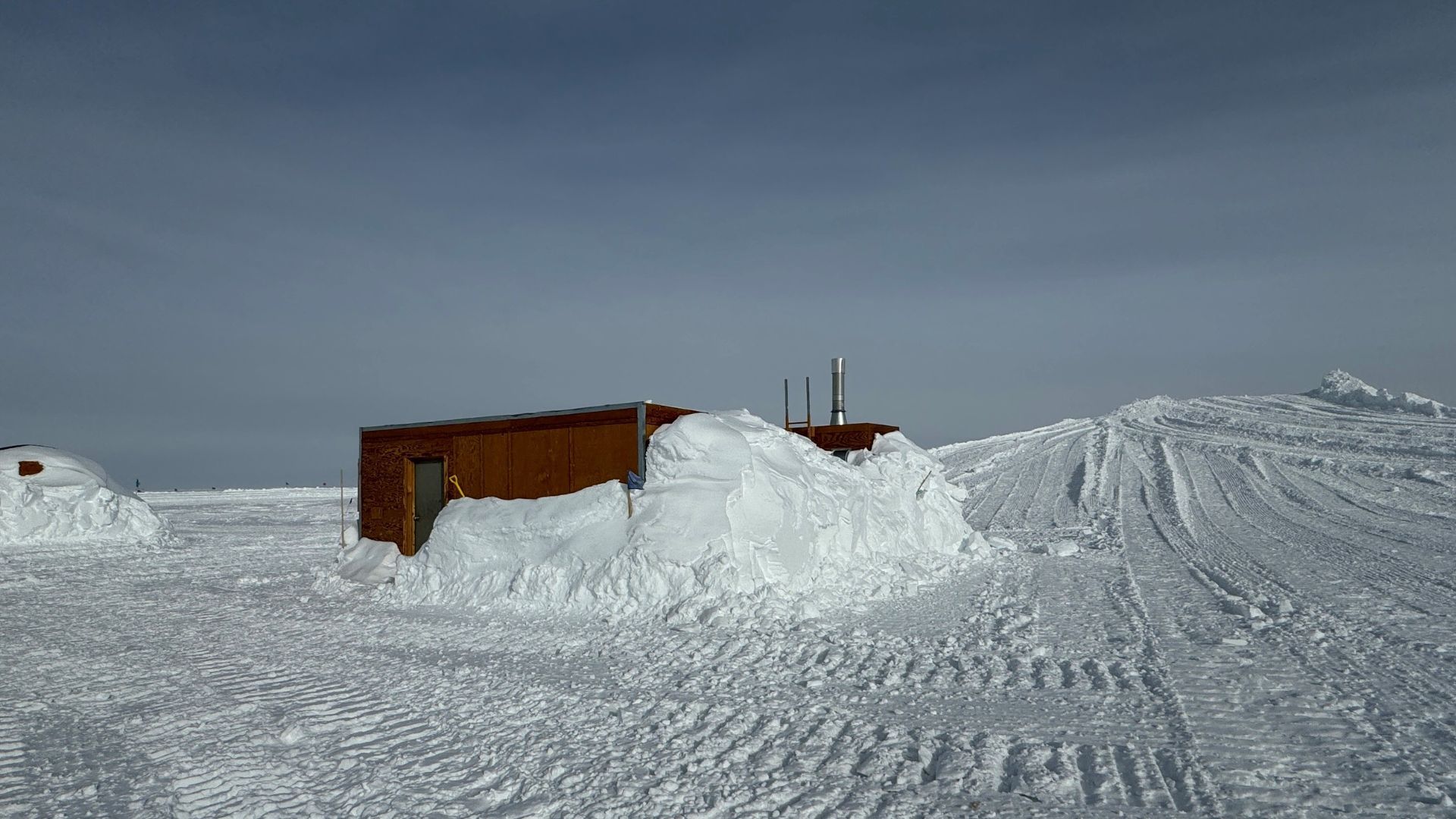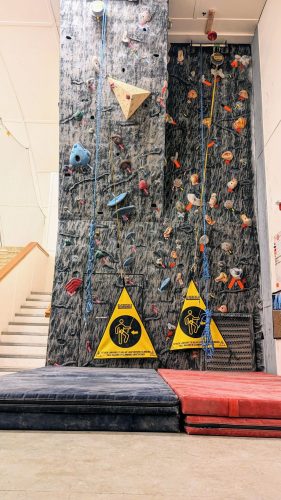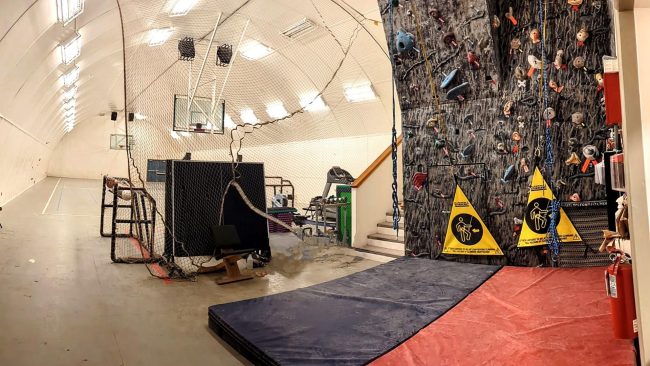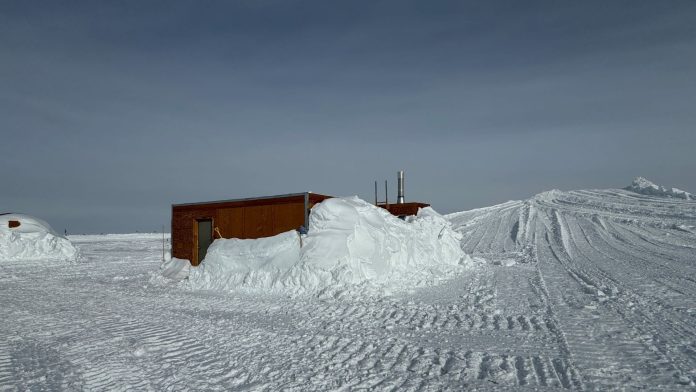
Amundsen Scott South Pole and McMurdo Stations
Antarctica
Specs: Antarctica is the only continent that does not have a smattering of commercial climbing gyms, but climbers living on “The Ice” are still finding ways to climb indoors. Recently, CBJ interviewed Antarctic workers Bill Coughran and Roy Perez about the indoor climbing options on the U.S. Antarctic bases. While many workers opt for more traditional base activities—such as watching movies, playing board games and gym sports, or attending social events—there is a collection of folks who spend idle time climbing. Both the Amundsen Scott South Pole and McMurdo U.S. Stations feature climbing options—bouldering and roped climbing, respectively—built by the team on hand. And while the walls could pass for a traditional rec center or homewall to the untrained eye, closer inspection reveals various gym-like aspects, from commercial holds to belay certification courses and even competitions.
Amundsen Scott South Pole Station
The Amundsen Scott South Pole Station is home to a 120-square-foot building resembling a shed, covered floor to ceiling in climbing holds—some professionally manufactured, some homemade. Built off the main workstation that hosts many scientists, engineers and researchers, the climbing wall was established in the late 1990s after climbers on staff received permission to use the camp weight room for this purpose, according to Bill Coughran, Leidos Analyst supporting the United States Antarctic Program (USAP). The wall created a recreational outlet in the base’s limited available space, allowing “experienced and novice climbers to practice and learn the climbing craft,” Coughran said. “We attached homemade holds on the wall in the weight room with mattresses as a cushioning for the floor. Gradually, commercially available holds were added over time and have replaced the original homemade holds.”
Andrea Dixon, Acting South Pole Area Manager, said the gym was constructed with local personnel. “We often have carpenters making improvements around station in their off time for fun,” she said. “This was one of those projects.” Now, the wall offers 320 square feet of climbing wall surface on walls reaching eight feet and is informally operated by the base’s staff—there aren’t any day passes or additional features, holds are purchased through a limited recreation budget, and participants can tweak and add routes at their pleasure.

The climbing community at the Amundsen Scott station is “very informal and individual,” Coughran said, with less than a half-dozen climbers on average. The gym usage varies, depending on the season, and is mainly used as a recreational opportunity on off days. In most seasons climbing is a fringe activity, though Coughran noted “there always seems to be one or two” climbers on base. The wall also provides a “sense of sanctuary,” described Coughran. “The gym is in an older, somewhat remote part of the base, and that remoteness adds to the feeling of getting out.”
The challenges the climbing gym faces are not very traditional. For example, “The building is becoming buried in snowdrift over time and is not a high-priority station building,” Coughran said. “It’s part of an older portion of the station campus that will eventually see change as facilities get refurbished or replaced. Lots of shoveling is involved to dig down into the doorway of the building.” But the wall persists, kept alive by the staff who stop by for a climbing session in a remote place.
McMurdo Station
The current McMurdo Station was the result of a request made in 2011 after the station’s original climbing wall was decommissioned in 2009, according to Roy Perez, the Recreation Supervisor supporting USAP. In the station’s traditional fitness gym, in-house carpenters and welders built a 30-foot climbing wall with two top rope lines. The wall typically has at least three routes set on each of the lines—an easy, intermediate and expert line.

Like the wall at Amundsen Scott, the McMurdo Station climbing wall is unstaffed. “Volunteers are the heart and soul of this community. We have many talented individuals [who] are willing to share their time and experience with the community,” Perez said. “Among the population, there are many climbers, with various levels of experience [who] take the time to maintain the gear and set routes and teach safety and how to belay.” Some of the more experienced climbers are the designated routesetters, often setting new routes after work.
The climbing wall is 480 square feet and the surrounding area features hangboards, a campus board with multiple hold sizes, auto belays, as well as rental shoes, grigris and chalk. A purchase request is created for any equipment needed, including holds. No fees or passes are necessary for climbers, and any climber who has passed the belay certification course may check out the key to climb. A belay class is hosted on Tuesdays for aspiring or existing climbers, contributing to the large percentage of climbers stationed at McMurdo—out of the 800 workers at McMurdo during the time of the interview, 176 were belay certified. “Of course, not all of them climb regularly, but it’s nice to have [the wall] as an option,” Perez added.

The climbers at McMurdo aren’t the only ones in the region. According to Perez, the workers at Scott Base—the New Zealand station located 3 km (1.9 mi) away—have a small bouldering gym. “We tend to be fairly competitive with each other in several sports,” Perez said. “We plan on having some climbing competitions between the bases. They will send some [climbers] to top rope and we will send some to boulder!”
According to Perez, the greatest challenge for the gym is continuity: “It is fairly easy to keep the gym active year to year with volunteers, but because we are all seasonal employees, long-term plans are difficult to execute,” he explained. “Many people come back year after year, but many only come for a season or two and move on. So, there are plenty of great ideas to think about, but when their contract is over, they move on to something else.”
Walls: Owner/contractor
Flooring: Mattresses, Stock McMurdo “Big Gym” Flooring
Website: www.usap.gov
In Their Words: “Climbing offers a unique version of a flow state. For avid climbers, it’s nice they can stay fit while here on the ice, but also get the mental challenge of climbing. For beginners, it’s a great way to learn something new without the intimidation of so many eyes in a commercial gym.” – Roy Perez, Recreation Supervisor supporting USAP

Naomi is a personal trainer and a routesetter who has also worked at climbing gyms as a youth team coach. After starting college at Colorado State University in 2017, she wanted to make new friends and found climbing, fell in love, and now climbing dictates most of what she does. Naomi earned a bachelor’s degree in Ecosystem Science & Sustainability, and when not climbing she enjoys baking, gardening and crafting.










